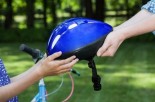Unfortunately, every sport carries some level of risk.
In addition to football, sport-related concussions are common in other youth and high school sports like soccer, lacrosse, basketball, hockey, and cheerleading.
Not all concussions can be prevented, but some may be avoided.
It's important to teach your child to never ignore a head injury, no matter how minor.
Cynthia LaBella, MD, explains the symptoms of concussion and the risk for long-term complications.
Concussions: Prevention, Symptoms & Knowing When to Return to Play

Featuring:
 Cynthia LaBella, MD, is the Medical Director of the Institute for Sports Medicine at the Ann & Robert H. Lurie Children’s Hospital of Chicago and Associate Professor of Pediatrics at Northwestern University’s Feinberg School of Medicine.
Cynthia LaBella, MD, is the Medical Director of the Institute for Sports Medicine at the Ann & Robert H. Lurie Children’s Hospital of Chicago and Associate Professor of Pediatrics at Northwestern University’s Feinberg School of Medicine.
After earning her medical degree from Cornell University Medical College in New York and finishing a residency in pediatrics at Johns Hopkins Hospital in Baltimore, Dr. LaBella completed a sports medicine fellowship at the University of North Carolina at Chapel Hill. She is board certified in both Pediatrics and Sports Medicine, and joined Lurie Children’s in 2004 to develop a comprehensive program in pediatric sports medicine, encompassing clinical care, research, and community outreach.
Dr. LaBella has served as team physician for high school, college, elite, and professional teams, including DePaul University and the Chicago Fire. She is currently the team physician for DeLaSalle high school, Moody Bible Institute, North Side Youth Football League, and the United States Rhythmic Gymnastics team.
She served on the executive committee of the American Academy of Pediatrics Council on Sports Medicine and Fitness (COSMF) for seven years as the COSMF policy coordinator, and was recently elected chairperson. She also serves on the sports medicine advisory committees for the Illinois High School Association, YMCA of the USA, and Pop Warner Football.
Her research efforts focus on identification of risk factors for injury in youth sports and development of strategies for prevention. She has won two awards for her 2006 research demonstrating that a coach-led neuromuscular warm-up reduces knee and ankle injuries in girls’ soccer and basketball at Chicago Public High Schools. This study was published in the November 2011 issue of the Archives of Pediatrics and Adolescent Medicine.
Cynthia LaBella, MD
 Cynthia LaBella, MD, is the Medical Director of the Institute for Sports Medicine at the Ann & Robert H. Lurie Children’s Hospital of Chicago and Associate Professor of Pediatrics at Northwestern University’s Feinberg School of Medicine.
Cynthia LaBella, MD, is the Medical Director of the Institute for Sports Medicine at the Ann & Robert H. Lurie Children’s Hospital of Chicago and Associate Professor of Pediatrics at Northwestern University’s Feinberg School of Medicine. After earning her medical degree from Cornell University Medical College in New York and finishing a residency in pediatrics at Johns Hopkins Hospital in Baltimore, Dr. LaBella completed a sports medicine fellowship at the University of North Carolina at Chapel Hill. She is board certified in both Pediatrics and Sports Medicine, and joined Lurie Children’s in 2004 to develop a comprehensive program in pediatric sports medicine, encompassing clinical care, research, and community outreach.
Dr. LaBella has served as team physician for high school, college, elite, and professional teams, including DePaul University and the Chicago Fire. She is currently the team physician for DeLaSalle high school, Moody Bible Institute, North Side Youth Football League, and the United States Rhythmic Gymnastics team.
She served on the executive committee of the American Academy of Pediatrics Council on Sports Medicine and Fitness (COSMF) for seven years as the COSMF policy coordinator, and was recently elected chairperson. She also serves on the sports medicine advisory committees for the Illinois High School Association, YMCA of the USA, and Pop Warner Football.
Her research efforts focus on identification of risk factors for injury in youth sports and development of strategies for prevention. She has won two awards for her 2006 research demonstrating that a coach-led neuromuscular warm-up reduces knee and ankle injuries in girls’ soccer and basketball at Chicago Public High Schools. This study was published in the November 2011 issue of the Archives of Pediatrics and Adolescent Medicine.